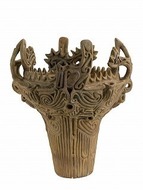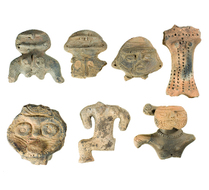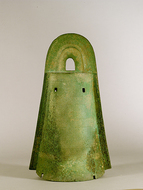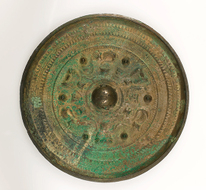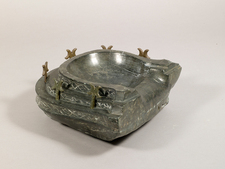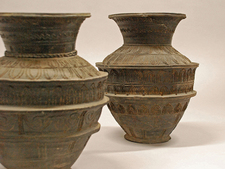- Top
- Permanent Exhibitions
- Archaeology
Archaeology is the study of human history from preliterate society until today primarily through
research into artifacts, structures, and objects found buried in the earth. In this exhibition, we
present archaeological materials collected by the university since its founding. These materials offer
a view of the history of the Japanese Islands and their place in the world. We combine these
materials with the findings of archaeological research conducted by humanities scholars and scholars
of Shinto archaeology here at Kokugakuin University. This exhibition seeks to use these material
objects as a way to present the spiritual lives (kokoro) of the people who have lived on these islands.
On occasion in this museum, some materials which are in the publication are not exhibited as they are changed on demand.
Catalogue
-
Deep pot
Deep pot(umataka type, flame-style pottery), Middle Jōmon period, ca. 3,000 B.C.E.
Iwanohara site, Fukasawamachi, Nagaoka City, Niigata Pref.The Iwanohara site located on the terrace of the left bank of the Shinano River is a large-scale site occupied from the middle to l...more
-
Clay figurine (dogū)
Late Jōmon-final Jōmon period, ca. 2500-300 B.C.E.
Tatsugi shell mound, Tatsugi, Tone Town, Ibaraki Pref., Shinpukuji shell mound, Iwatsuki Ward, Saitama City, Saitama Pref., etc.Human figurines from the Jōmon period are thought to represent a belief in supernatural beings. While produced from the earlie...more
-
Bronze bell (dōtaku)
Bronze bell (dōtaku) with crossed-bands pattern Thought to have been excavated from the Ōiwayama site, Koshinohara,Yasu City, Shiga Pref.
Middle Yayoi period, ca.1st century B.C.E.These artifacts are called the "Tossenchū type 1"; among bronze bells characterized by cross-band patterns of six sections dr...more
-
Bronze mirror
Bronze mirror with triangular rim, design of three deities and three animals, Early Kofun period, ca. 4th century C.E.
From the Ōtsuki Bankei collectionThis mirror is believed to belong to one of the last groups of imported mirrors, prior to the socalled imitative triangular rimm...more
-
Pottery
Pottery with human face and raised hands Early Kofun period, ca. 4th century C.E.
Katayama site, Wakaho-Hoshina, Nagano City, Nagano Pref.Located on the southern bank of the Hoshina River (tributary of the Chikuma River), the Katayama site is an unusual archaeologi...more
-
Stone pillow
Stone pillow (Important Cultural Property) Middle Kofun period, ca. 5th century C.E. Gift of the Archaeological Society of Kokugakuin University
Anesaki Futagozuka Tumulus, Anesaki, Ichihara City, Chiba Pref.The Anesaki Futagozuka Tumulus located in the Yōrō River basin is a keyhole-shaped tomb mound that can be dated to the late-midd...more
-
Cinerary urn
Heian period, ca. 9th century C.E.
Kaneda Government Office site (found within the Kokonoe-Higashioka abandoned temple site), Higashioka, Tsukuba City, Ibaraki Pref.The ruins of the ancient Kaneda Government Office site are located in the west-bank river basin of the Sakura River. The site rep...more













